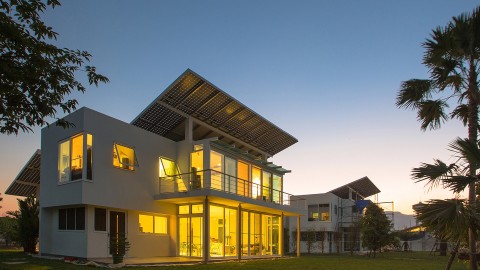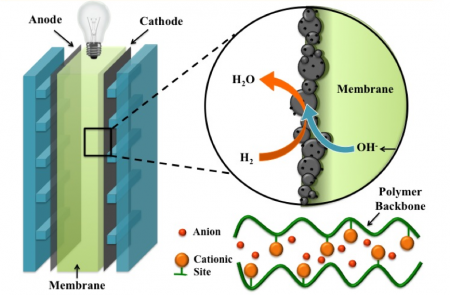January 11, 2016 – Today’s guest bloggers are Sebastian-Justus and Jan Schmidt. I was approached by one of their colleagues about the technology they describe here back in November of last year and was immediately intrigued – using hydrogen storage along with solar power for residential renewable energy. A bit about both of them.
Sebastian-Justus lives in Chiang Mai, Thailand. He is an adviser to several companies, the conceiver of the Phi Suea House (more on that later) and describes his personal motivation as wholly philanthropic. I quote him, “Everyone should do something to live in a better world. We are now doing our part – leave the world more green while gaining and sharing knowledge. This is without a doubt worth all money spent.”
Jan is Sebastian’s co-conspirator and contributor to this posting. Jan, an Aerospace Engineer, a graduate of University of Sheffield in the United Kingdom, was intrigued by Sebastian proposed residential system employing both solar power and hydrogen and accepted the challenge of implementing the project. Their Phi Suea House will be the world’s first 24-hour solar-powered hydrogen storage residence and opens on Friday, January 29, 2016. Visit the CNX Construction site for more information.
———-
Phi Suea (seen in the picture above) is multi-house project first conceived by Sebastian-Justus Schmidt after he attended a 2013 telecom exhibition and saw a hydrogen-powered base station used by mobile phone operators in the event of power failures. It gave him the idea to deploy similar technology for use in homes. This month, on January 29th, the public is invited to see the end result in Chiang Mai, Thailand. Sebastian describes his inspiration as follows, “It is like applying the knowledge from a physics lesson at school, to practical use.”
CNX Construction built Phi Suea, a compound containing 4 family homes plus support buildings, off the grid and fully powered by photovoltaic panels and a unique hydrogen energy storage system. Installed photovoltaic capacity is 86 Kilowatts. During the day excess solar energy gets routed to an electrolyser which separates water into hydrogen and oxygen. Compressed hydrogen gets stored in tanks on site, and when there is no sun, the gas is fed into fuel cells where it generates electricity.
The technology breakthrough is the storage system. Today the biggest impediment to mass adoption of solar panels is the lack of 24/7 energy reliability. If the sun doesn’t shine, or it’s a cloudy day, solar panels have no or limited ability to generate electricity. Companies like Tesla use lithium-ion battery stacks (the Powerwall) as a way of bridging solar’s interruptability. But batteries have a limited life, good for at the best several thousand recharge cycles before they have to be replaced. And then you have to dispose of them which can be environmentally unfriendly.
Phi Suea uses hydrogen rather than batteries to bridge solar power interruptions. It separates hydrogen from water when the sun is shining and stores the gas in tanks where it then is released on demand to power fuel cells. Each hydrogen tank has a capacity to store 130 Kilowatt hours of energy, enough to power fuel cells continuously for more than 30 hours.
Why hydrogen?
Because it is 100% clean energy storage. There is zero carbon output and no environmentally dangerous chemicals or material to recycle. To get hydrogen requires its separation from water using an electrolyser. Electrolysers in the past have been expensive because the catalysts require the use metals like iridium, gold and platinum.
The technology used at Phi Suea, however, employs an anion exchange membrane (AEM) seen in the image below. The alkaline solid polymer used by the AEM is inexpensive and capable of producing compressed hydrogen directly for storage at a fraction of the cost of past electrolyser technologies and batteries.
Phi Suea’s design implements sustainability as well as off-the-grid energy independence. This makes it adaptable to many localities. Passive solar heating panels provide all hot water requirements with well-insulated storage tanks keeping water at temperatures exceeding 8o degrees Celsius (176 Fahrenheit) for days, whether the sun is shining or not. The water collection system consists of a 1,000 cubic meter underground reservoir where rain and irrigation water pass through sedimentation and aeration chambers before being recycled. Solar-powered fishponds provide a protein source and use 6-Kilowatt capacity solar panels for energy to pump water through sediment and natural coral filters at a rate of 100 cubic meters per hour keeping it aerated and clean. And all homes on site feature automated systems to further conserve energy. Cost recovery for the build and operation is estimated to be 15 years. Over time as more Phi Suea communities are built, the return-on-investment should come even sooner.











[…] Electrolyser produces hydrogen to supplement solar renewable energy feeding fuel cells.Thailand site goes public on January 29, 2016. […]